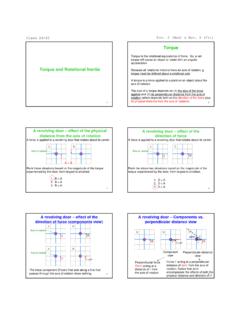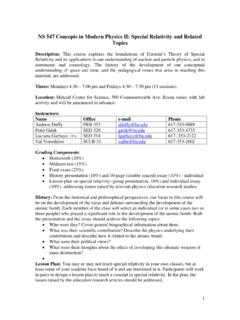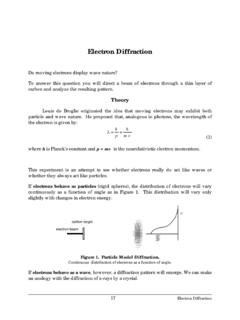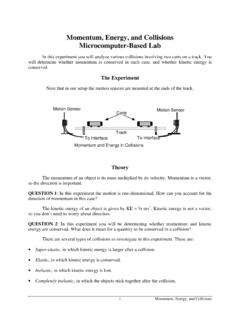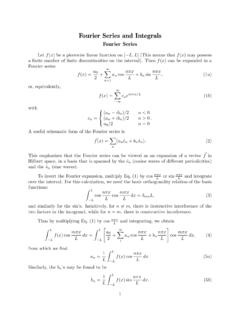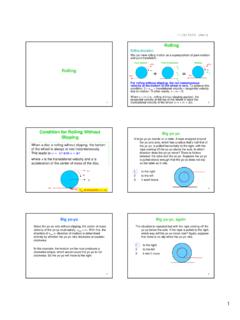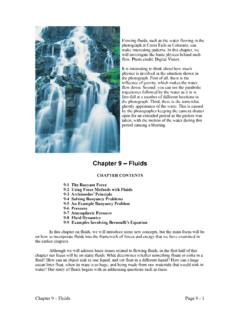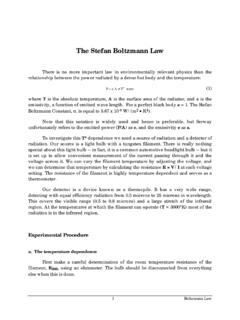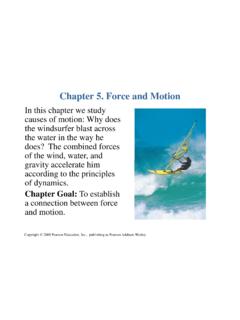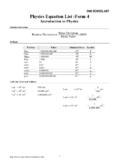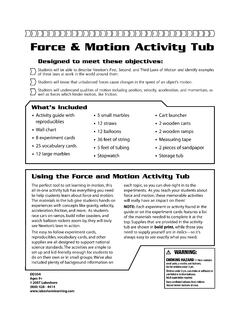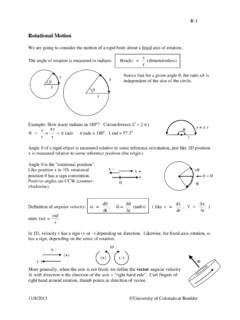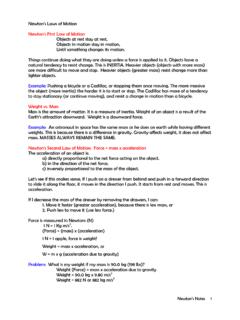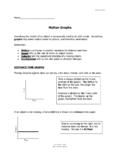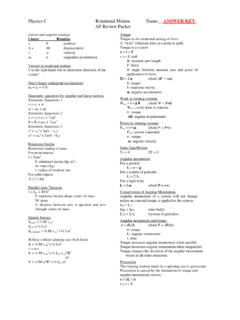Transcription of 2-1 Position, Displacement, and Distance
1 2- 1 position , displacement , and DistanceIn describing an object s motion , we should first talk about position where is the object? A position is a vector because it has both a magnitude and a direction: it is some Distance from a zero point (the point we call the origin) in a particular direction. With one-dimensional motion , we can define a straight line along which the object moves. Let s call this the x-axis, and represent different locations on the x-axis using variables such as and , as in Figure an object moves from one position to another we say it experiences a displacement . In Figure , we defined the positions = +3 m and = 2 m. What is the displacement in moving from position to position ?
2 Applying Equation gives . This method of adding vectors to obtain the displacement is shown in Figure Note that the negative sign comes from the fact that the displacement is directed left, and we have defined the positive x-direction as pointing to the determine the displacement of an object, you only have to consider the change in position between the starting point and the ending point. The path followed from one point to the other does not matter. For instance, let s say you start at and you then have a displacement of 8 meters to the left followed by a second displacement of 3 meters right. You again end up at, as shown in Figure The total Distance traveled is the sum of the magnitudes of the individual displacements, 8 m + 3 m = 11 m.
3 The net displacement (the vector sum of the individual displacements), however, is still 5 meters to the left: .Chapter 2 motion in One Dimension Page 2 - 2 displacement : a vector representing a change in position . A displacement is measured in length units, so the MKS unit for displacement is the meter (m).We generally use the Greek letter capital delta (!) to represent a change . If the initial position is and the final position is we can express the displacement as: . (Equation : displacement in one dimension)Figure : Positions = +3 m and = 2 m, where the + and signs indicate the : The displacement is 5 m when moving from position to position .
4 Equation , the displacement equation, tells us that the displacement is , as in the figure. The bold arrow on the axis is the displacement , the vector sum of the vector and the vector .EXAMPLE Interpreting graphsAnother way to represent positions and displacements is to graph the position as a function of time, as in Figure This graph could represent your motion along a sidewalk.(a) What happens at a time of t = 40 s?(b) Draw a diagram similar to that in Figure , to show your motion along the sidewalk. Add circles to your diagram to show your location at 10-second intervals, starting at t = the graph in Figure , find (c) your net displacement and (d) the total Distance you covered during the 50-second (a) At a time of t = 40 s, the graph shows that your motion changes from travel in the positive x-direction to travel in the negative x-direction.
5 In other words, at t = 40 s you reverse direction.(b) Figure shows one way to turn the graph in Figure into a vector diagram to show how a series of individual displacements adds together to a net displacement . Figure shows five separate displacements, which break your motion down into 10-second intervals.(c) The displacement can be found by subtracting the initial position , +20 m, from the final position , +60 m. This gives a net displacement of .A second way to find the net displacement is to recognize that the motion consists of two displacements, one of +80 m (from +20 m to +100 m) and one of 40 m (from +100 m to +60 m). Adding these individual displacements gives.
6 (d) The total Distance covered is the sum of the magnitudes of the individual displacements. Total Distance = 80 m + 40 m = 120 End-of-Chapter Exercises: 7 and 9 Essential Question : In the previous example, the magnitude of the displacement is less than the total Distance covered. Could the magnitude of the displacement ever be larger than the total Distance covered? Could they be equal? Explain. (The answer is at the top of the next page.)Chapter 2 motion in One Dimension Page 2 - 3 Figure : A vector diagram to show your displacement , as a sequence of five 10-second displacements over a 50-second period. The circles show your position at 10-second : The net displacement is still 5 m, even though the path taken from to is different from the direct path taken in Figure : A graph of the position of an object versus time over a 50-second period.
7 The graph represents your motion in a straight line as you travel along a to Essential Question : The magnitude of the net displacement is always less than or equal to the total Distance . The two quantities are equal when the motion occurs without any change in direction. In that case, the individual displacements point in the same direction, so the magnitude of the net displacement is equal to the sum of the magnitudes of the individual displacements (the total Distance ). If there is a change of direction, however, the magnitude of the net displacement is less than the total Distance , as in Example velocity and SpeedIn describing motion , we are not only interested in where an object is and where it is going, but we are also generally interested in how fast the object is moving and in what direction it is traveling.
8 This is measured by the object s velocity . Average velocity : a vector representing the average rate of change of position with respect to time. The SI unit for velocity is m/s (meters per second).Because the change in position is the displacement , we can express the average velocity as: . (Equation : Average velocity )The bar symbol ( _ ) above a quantity means the average of that quantity. The direction of the average velocity is the direction of the displacement . velocity and speed are often used interchangeably in everyday speech, but in physics we distinguish between the two. velocity is a vector, so it has both a magnitude and a direction, while speed is a scalar.
9 Speed is the magnitude of the instantaneous velocity (see the next page). Let s define average Speed = (Equation : Average speed) In Section 2-1, we discussed how the magnitude of the displacement can be different from the total Distance traveled. This is why the magnitude of the average velocity can be different from the average Average velocity and average speedConsider Figure , the graph of position -versus-time we looked at in the previous section. Over the 50-second interval, find:(a)the average velocity , and (b) the average (a) Applying Equation , we find that the average velocity is: . Chapter 2 motion in One Dimension Page 2 - 4 Figure : A graph of your position versus time over a 50-second period as you move along a net displacement is shown in Figure We can also find the net displacement by adding, as vectors, the displacement of +80 meters, in the first 40 seconds, to the displacement of 40 meters, which occurs in the last 10 seconds.
10 (b) Applying Equation to find the average speed, .The average speed and average velocity differ because the motion involves a change of direction. Let s now turn to finding instantaneous values of velocity and speed. Instantaneous velocity : a vector representing the rate of change of position with respect to time at a particular instant in time. A practical definition is that the instantaneous velocity is the slope of the position -versus-time graph at a particular instant. Expressing this as an equation: . (Equation : Instantaneous velocity ) is sufficiently small that the velocity can be considered to be constant over that time speed: the magnitude of the instantaneous Instantaneous velocityOnce again, consider the motion represented by the graph in Figure What is the instantaneous velocity at (a) t = 25 s?

